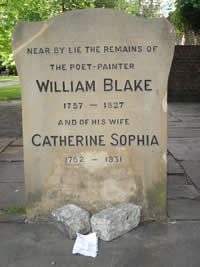On this day in 1827, William Blake died as he had lived, in poverty and obscurity. What can be said about this visionary, mystic, prophet, poet, painter, engraver, and World Artist? The neglect that one of the Greatest-Evers suffered in his lifetime is criminal yet essential to consider, so central is it to his story and posthumous reputation. We marvel at Blake’s art, but also his resolve as he ceaselessly put himself through unimaginable rigours of creating gnostic works even though no one gave a fuck. But here in the 21st century, William Blake is the ultimate Heroic Artist. Having never compromised his art with commercial concerns, he is the blueprint for all who seek and pursue truth and art with no separation.
The recent restaging at Tate Britain of Blake’s 1809 exhibition, “Paintings in Fresco, Poetical and Historical Inventions” – which the artist held above his brother’s hosier’s shop in Broad Street – was a stark reminder of what must have been the reality of such contemptuous neglect. Fifty-two years old and exhausted by a tireless output that was continually met with indifference and ridicule, Blake’s attempt to draw attention to his genius with a display of his drawings, engravings and illustrations was a spectacular failure. None of the pictures sold, and there was but one review: The Examiner’s Robert Hunt was vicious, condemning Blake as “an unfortunate lunatic.” The 1809 exhibition was accompanied by a 66-page catalogue in the form of an artistic manifesto. “The ignorant Insults of Individuals will not hinder me from doing my duty to my Art,” Blake wrote. The reality, however, must have stung. He would never again show his work in public.
How cruel and alienating it must have been to live in a world which distrusted and despised him. But shortly before his death at the age of sixty-nine, William Blake was finally rewarded with a small taste of recognition when he was championed by a circle of visionary artists who called themselves the Ancients: John Linnell, Samuel Palmer, Edward Calvert and George Richmond honoured Blake as the seer that he was, and were there to mourn him when he was buried in an unmarked grave at London’s Bunhill Fields, atop three other bodies and soon to be followed by four more, including his beloved and devoted wife, Catherine.
Ten years ago in April 2007 – during a year of national events to celebrate the 250th anniversary of Blake’s birth – I visited William and Catherine’s memorial stone at Bunhill Fields with two of our best friends: Psychedelic Paul, author of the 13th Floor Elevators’ biography, Eye Mind; and Gyrus, gnostic voyager and author of Archaeologies of Consciousness. It was a beautiful, warm spring day and we walked around, trying to divine the true location of Blake’s body – all of us no doubt lost in our own thoughts about the man who meant nothing in his time but means so much in ours; whose creative output was so vast and for whom no task, however arduous, was too great; whose courage and convictions to his artistic integrity and duty never strayed; the artist above all others who inspires those who seek inspiration.
I watched as a skylark circled above before landing on William and Catherine’s memorial stone and remembered one of my favourite Blake quotations: “No bird soars too high, if he soars with his own wings.”



5 Responses to 12th August 1827 – the Death of William Blake